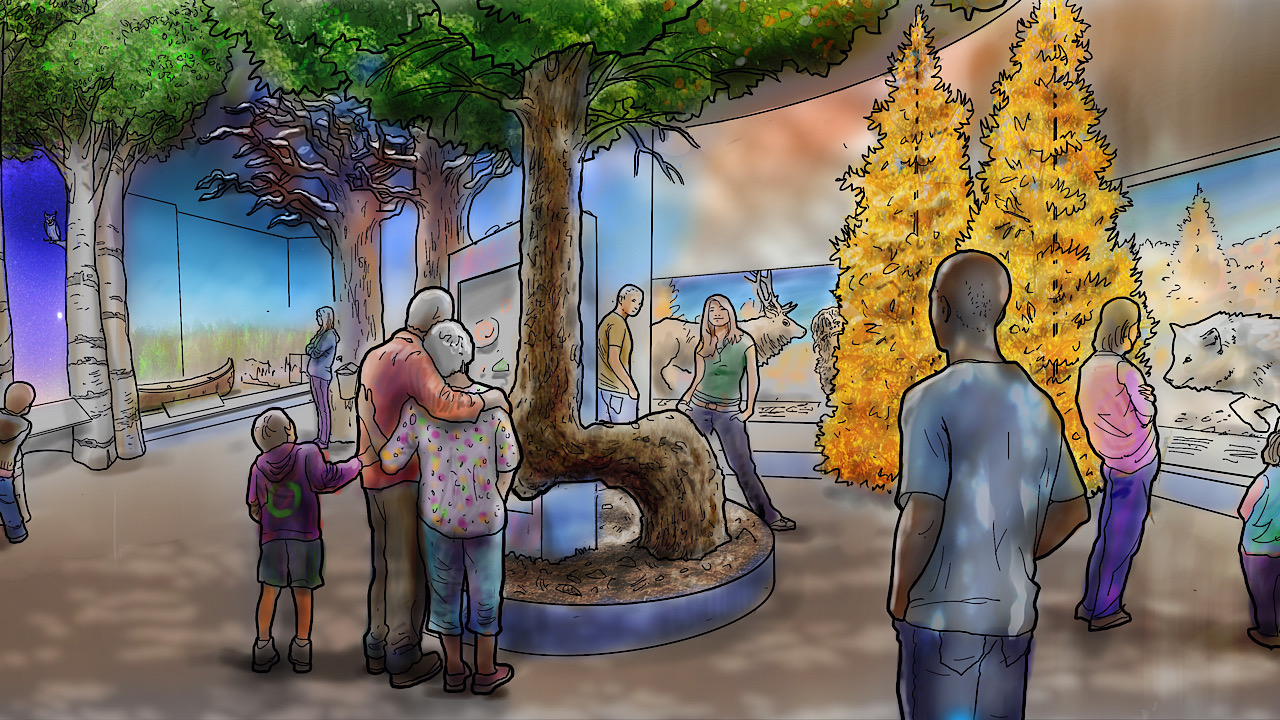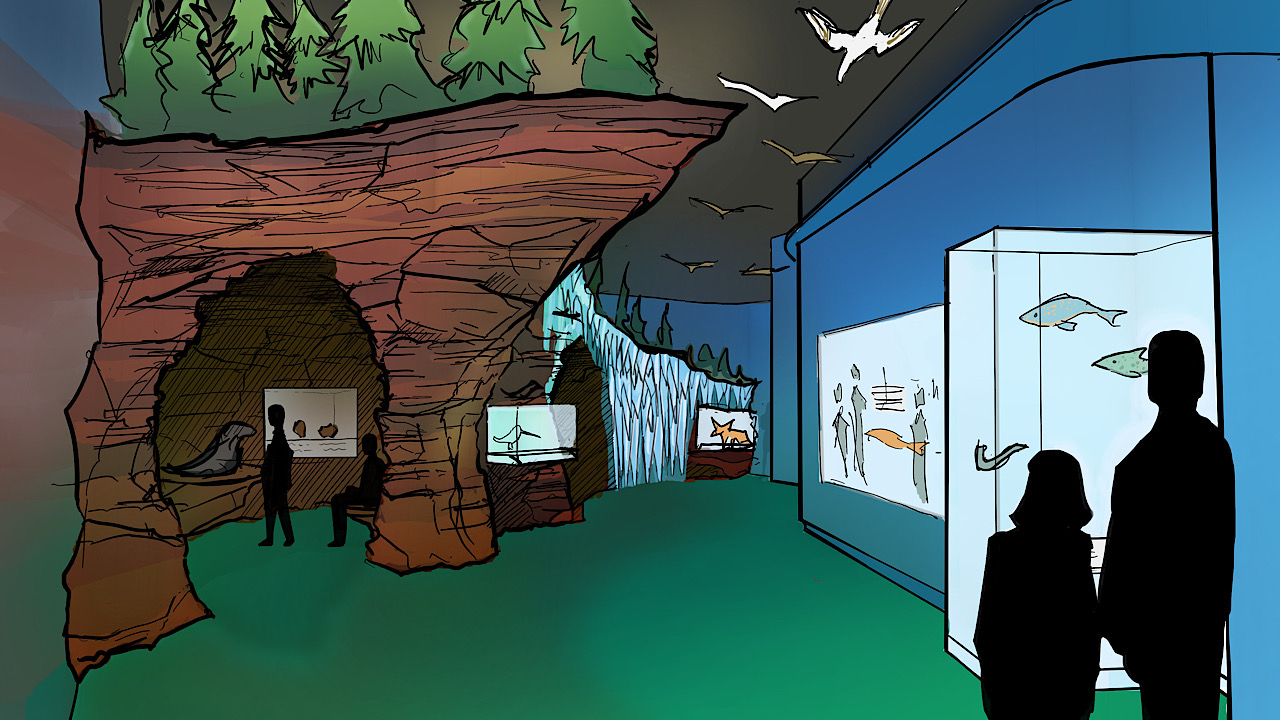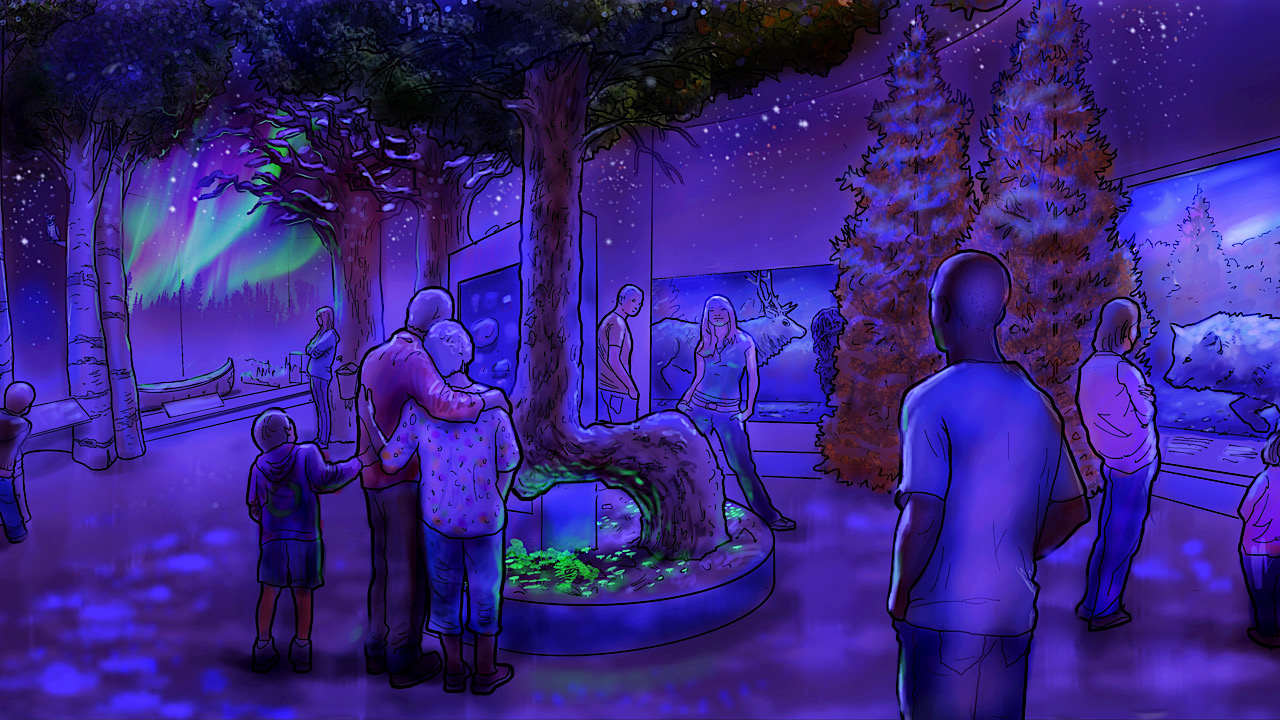The Milwaukee Public Museum on Thursday unveiled sketches of the “Wisconsin Journey” gallery to be housed at its future facility.
Wisconsin Journey will be an entire exhibit floor focused on the geological wonders and array of cultures of Wisconsin, taking visitors on an immersive trip around the state through an exploration of six distinct areas of Wisconsin: the Driftless Area, Apostle Islands, Northwoods, prairielands, Great Lakes and Door Peninsula. The gallery will also examine how people are part of Wisconsin’s many wonders and share the responsibility and privilege of caring for them, according to a news release.
It’s the second of five permanent galleries MPM and New York City-based Thinc Design will reveal in the coming weeks, in an effort to generate public excitement and donor support. The “Time Travel” gallery was unveiled earlier this month.
“At the outset of this once-in-a-generation project, MPM staff took a tour of Wisconsin with our design partners to draw inspiration from the natural landscapes and cultural traditions that make Wisconsin a diverse, unique place,” said Ellen Censky, MPM president and chief executive officer. “That tour underscored the importance of and value in learning about the familiar, and the museum determined it wanted to explore Wisconsin in a way not done before.”
Thursday’s unveiling focused on the Driftless, prairie, Apostle Islands and Northwoods portions of the Wisconsin Journey gallery. Details about the Great Lakes and Door Peninsula exhibits will be revealed later.
The Driftless Area is located in the southwestern part of the state and, evidenced by its name, was untouched by glaciers. Throughout the Driftless exhibit, visitors will explore the region’s geological history and the ways in which the land gave rise to the lead mining industry. The “lead mine look-in” will be a key immersive exhibit and make visitors feel like they are inside a dark lead mine. Visitors will also be able to explore waterways through a tactile map of Wisconsin’s most significant rivers, the Mississippi and Wisconsin, to better understand how the region’s watery highways have connected people to the land.
Also located in the southern and western parts of the state, Wisconsin’s prairielands have long served as a key resource for agriculture. At the forefront of the Prairie exhibit, visitors will find the bison that is currently on display at MPM and learn about the animal’s role as a keystone species, including how that role has changed over time, Indigenous connections, extirpation of the species in Wisconsin and ongoing restoration efforts. A familiar site to return visitors, the Hebior Mammoth Dig Site exhibit will be a core scene in the gallery’s Prairie area, demonstrating how the giant Mammoth bones emerged from the dirt – as if just discovered by John Hebior – and asking questions about what the soil and its contents can teach us about life in Wisconsin.
“Visitors have long been greeted by the Hebior Mammoth, which stands in our current lobby space,” said Censky. “Discovered in Kenosha County on the property of John Hebior, 85% of the mammoth’s bones are intact and present – making the find significant for that reason alone. By analyzing marks on the bones, scientists have determined the animal was alive alongside its human butchers about 14,500 years ago – proving humans were in Wisconsin 1,000 years earlier than was previously thought.”
The Apostle Islands are situated along the state’s northernmost edge. The Apostle Islands exhibit at the future museum will showcase the drastic environmental shifts that occur there from summer to winter. Visitors can explore the rocky caves of Devils Island through graphic and tactile elements and learn about migratory birds from an overhead display throughout the Wisconsin Journey gallery.
The Northwoods exhibit seeks to honor a region close to the hearts of many Wisconsinites. Visitors will find exhibits depicting a rich woodland landscape and discover how the Northwoods – and the habits and habitats of its residents and visitors – shifts through the seasons and time of day. Choreographed lighting and soundscapes throughout the exhibit will shift the woodland space from day into night; stars will replace clouds in an environmental ceiling treatment, and the hoot of an owl will replace bird song. After a few minutes, “daylight” will return and the cycle will begin again.
Throughout the Wisconsin Journey exhibits and the future museum as a whole, stories about indigenous people will anchor exhibits and galleries to teach us about the various cultures and relationships that impact and are impacted by the land, MPM said.
As a result of a $1 million gift, Associated Bank will have its name on the Gathering and Education Space at the entrance of the exhibit and will support special programming and interactive learning experiences connected to the gallery’s theme. Associated Bank is among 20 benefactors that have made major gifts of $1 million or more to the Wisconsin Wonders fundraising campaign to build the new museum. All told, the campaign has now raised more than $128 million, including $45 million from Milwaukee County and $40 million from the state, toward the $240 million goal.
MPM’s three upcoming unveilings will provide an inside look at a sampling of exhibits, collections items and features visitors can expect to see at the future museum, which is on track to break ground late this year or early next year for a late 2026 completion.
Below is the gallery announcement schedule:
April 14: Milwaukee Revealed
“Milwaukee Revealed” will immerse visitors in city streetscapes they can explore to learn about the history of Milwaukee, the people who came to settle and live here and its interconnected systems, neighborhoods and ecologies (and where children can shop for a sweet treat).
May 9: Living in a Dynamic World and Mixing Zones
In the “Living in a Dynamic World” gallery, visitors will take an unconventional journey to five distinct ecosystems across the globe and be immersed in the landscapes and cultures that occupy them. The Mixing Zones, including the Burke Foundation Mixing Zone, are two spaces that will showcase a rotating selection of collection items, offer spaces for public interaction and programming and turn the museum “inside out” by providing behind-the-scenes views into the collections’ storage areas.
May 23: Rainforest, Daniel M. Soref Planetarium, Puelicher Butterfly Vivarium and the Bucyrus Rooftop Terrace
The “Rainforest” gallery will take visitors to the tropics to learn about the biodiversity that flourishes in tropical rainforests and the life rainforest climates support.
Below is a video summarizing MPM’s plans for its future Wisconsin Journey gallery:








